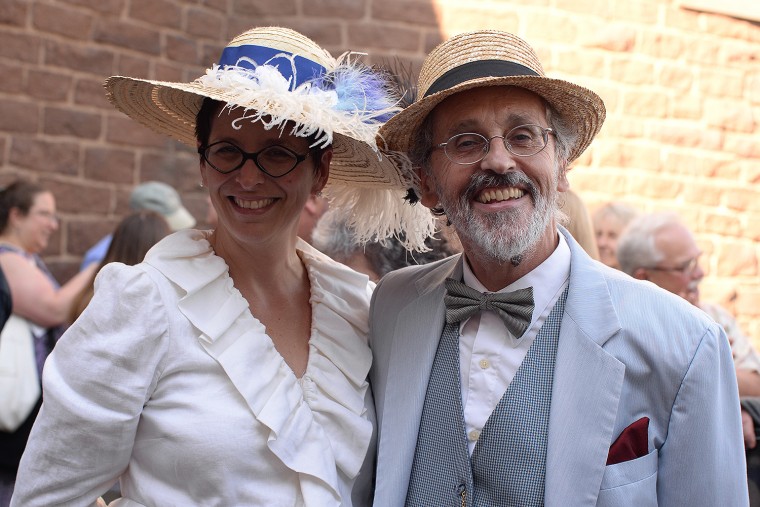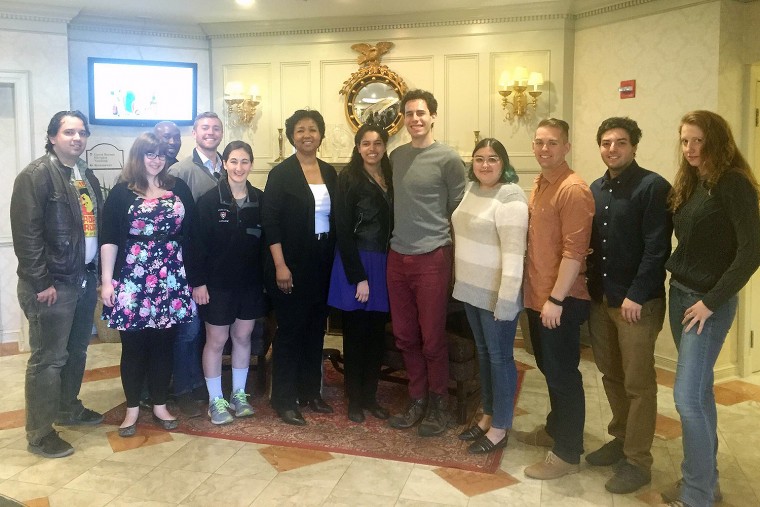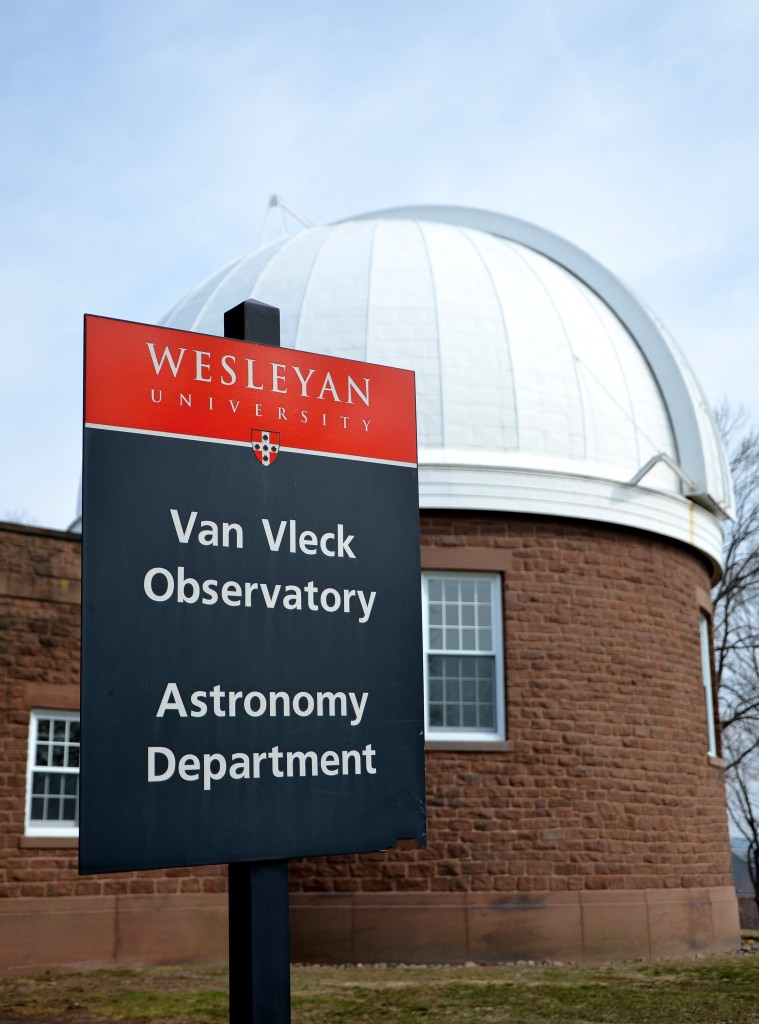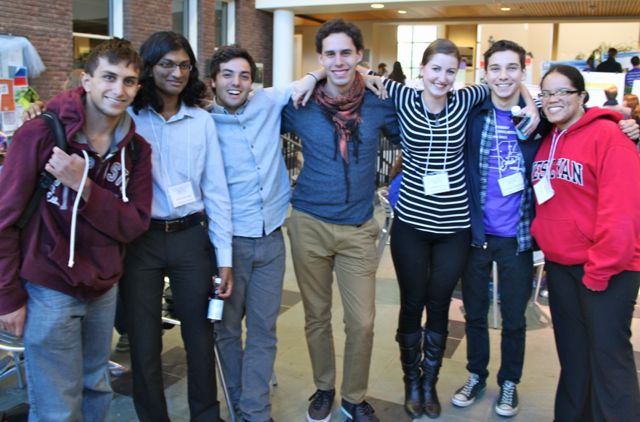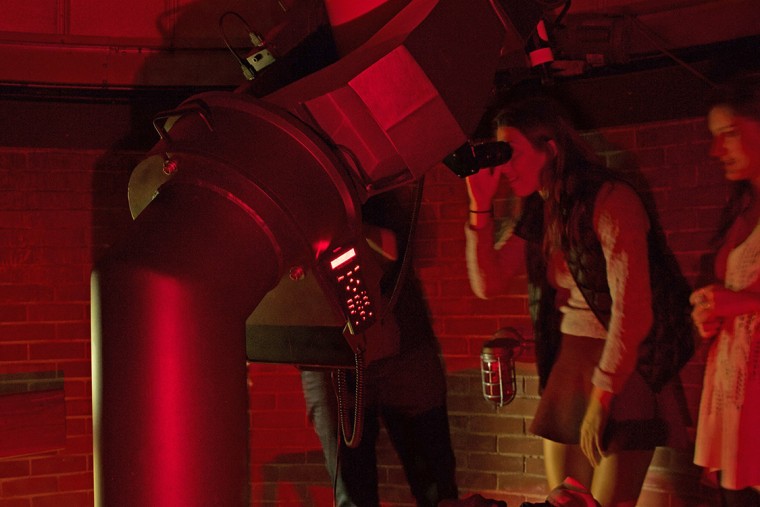Meredith Hughes, assistant professor of astronomy, is the co-author of "Debris Disks in the Scorpius-Centaurus OB Association Resolved by Alma," published in The Astrophysical Journal, Vo. 828, No. 1. Jesse Lieman-Sifry '15 also is a co-author of the article. In addition, the international weekly journal of science Nature mentioned the article in a Sept. 8 publication. The co-authors explored the idea of carbon-monoxide potentially being in large-star disks. As explained in her abstract, “Stars twice the size of the sun can feature carbon-monoxide-rich gas disks around them, contrary to the expectation that ultraviolet radiation would have stripped away the gas.” Hughes used the…
On June 16, the Astronomy Department hosted the Van Vleck Observatory Centennial Symposium: A Celebration of Astronomy at Wesleyan University. Wesleyan’s observatory has been celebrating its centennial during the 2015-16 academic year, with a series of events and an exhibition, "Under Connecticut Skies." The symposium was co-sponsored by the Astronomical Society of Greater Hartford (ASGH), and held in conjunction with StarConn. The exhibition was spearheaded by Roy Kilgard, support astronomer and research associate professor of astronomy, and Amrys Williams, visiting assistant professor of history. At the meeting, they discussed the exhibition, which was developed by a team of faculty, students and staff using the observatory's extensive collection of…
The Hartford Courant featured the 100th anniversary of Wesleyan's Van Vleck Observatory, which will be celebrated with an exhibit and a series of events this month and next. The "Under Connecticut Skies" exhibit, located in the observatory library, will open May 6 from 10 a.m. to 6 p.m., and will remain open indefinitely during the observatory's public hours. Amrys Williams, visiting assistant professor of history, who has been working on the exhibit since last year, said the Van Vleck Observatory and the astronomy department building are part of the exhibit, telling the story of how astronomers did their work 100 years ago.…
(more…)
Wesleyan's Van Vleck Observatory is celebrating its centennial this spring, with a series of events and an exhibition beginning in early May. On May 6, the observatory's library will reopen to the public with an exhibition on the history of astronomy at Van Vleck. Developed by a team of faculty, students, and staff, the exhibition will use the observatory's extensive collection of scientific instruments, teaching materials, photographs, drawings, and correspondence to illustrate both the changes in astronomical research and teaching over the past century, and the observatory's consistent mission of conducting instruction and research under the same roof. The exhibition will…
Award-winning science fiction writer Jack McDevitt MALS ’71 received an out-of-this-world honor: Lowell Observatory astronomer named an asteroid for him. In an e-mail, astronomer Lawrence Wasserman, explained, “I discovered the books of Jack McDevitt early in 2015 and spent most of the year plowing through every novel he has written. I was especially taken by his naming the first Mars spaceship for Percival Lowell, our founder. And, as a person who spent their teens in the ’60s reading Isaac Asimov and Arthur C. Clarke, I was very pleased to find someone who writes science fiction that doesn't have any elves, dwarfs,…
Two faculty members and three students have been awarded grants in the latest call for proposals from NASA's Connecticut Space Grant Consortium. Jim Greenwood, assistant professor of earth and environmental sciences, and Bill Herbst, the John Monroe Van Vleck Professor of Astronomy, professor of integrative sciences, were awarded $8,000 for a Faculty Collaboration Grant titled “Chondrule Formation Experiments.” This is to run high-temperature experiments on material that makes up meteorites in order to test a hypothesis that they put forward in a recent paper in Icarus this year. Seth Redfield, associate professor of astronomy, associate professor of integrative sciences, was awarded $1,500 for a STEM Education…
Bill Herbst, the John Monroe Van Vleck Professor of Astronomy, and James Greenwood, assistant professor of earth and environmental sciences, co-authored an article published in the planetary science journal Icarus. Their article, “A New Mechanism for Chondrule Formation: Radiative Heating by Hot Planetesimals” grew out of research seminars from the recently introduced Planetary Science graduate concentration and minor at Wesleyan. Their work focused on chondrules, or tiny spheres of molten rock that permeate primitive meteorites and date to very close to the beginning of the solar system. For decades, the existence of chondrules has puzzled astrophysicists and cosmochemists as no…
Kevin Flaherty, a postdoctoral researcher working with Meredith Hughes, assistant professor of astronomy, will speak on "Dusty Debris as a Window into New Planetary Systems" during the American Association for the Advancement of Science's (AAAS) 2016 Annual Meeting in Washington, D.C., Feb. 13. Flaherty is one of three symposium speakers who will discuss the theme "Planet Formation Seen with Radio Eyes." Scientists are now probing how, where, and when planets form and are analyzing the links between planetary system architecture and the properties of the parent circumstellar disk. Though the relationship of planetary to stellar masses remains obscure, it is clear that most…
Four Wesleyan undergraduates and a faculty member received awards in the latest call for proposals from NASA's Connecticut Space Grant Consortium. Astronomy major Rachel Aronow '17 was awarded an Undergraduate Research Fellowship in the amount of $5,000 for her project, "Planet Formation and Stellar Characteristics in Tatooine-like Systems." She is working with Bill Herbst, the John Monroe Van Vleck Professor of Astronomy, studying Tatooine-like systems (named after the fabled home system of Luke Skywalker), which are planet-forming disks that surround a close pair of stars that are in orbit around each other. Aronow conducted research with Herbst last summer, and these funds will support further…
The 26th Annual Undergraduate Research Symposium of the Keck Northeast Astronomy Consortium (KNAC) was held at Williams College on Oct. 17. Five students presented results of their summer research: Julian Dann '17, Aylin Garcia Soto '18, and Girish Duvvuri '17 delivered oral presentations while Rachel Aronow '17 and Avi Stein '17 presented a poster. Several other students came along to enjoy the weekend, which featured a dinner and social event on Friday night, the seminar on Saturday and breakout sessions on such topics as Inclusive Astronomy and how/why to program in Python. More than 100 students and faculty from KNAC attended the event (pictured…
Wesleyan's Women in Science (WIS) gathered at the Van Vleck Observatory on Oct. 8 for "Starry Night," an evening of stargazing, conversation and hot chocolate. Participants used the Astronomy Department's 16-inch Fiducia telescope to view the night sky. (Photos by Ryan Heffernan '16) (more…)


